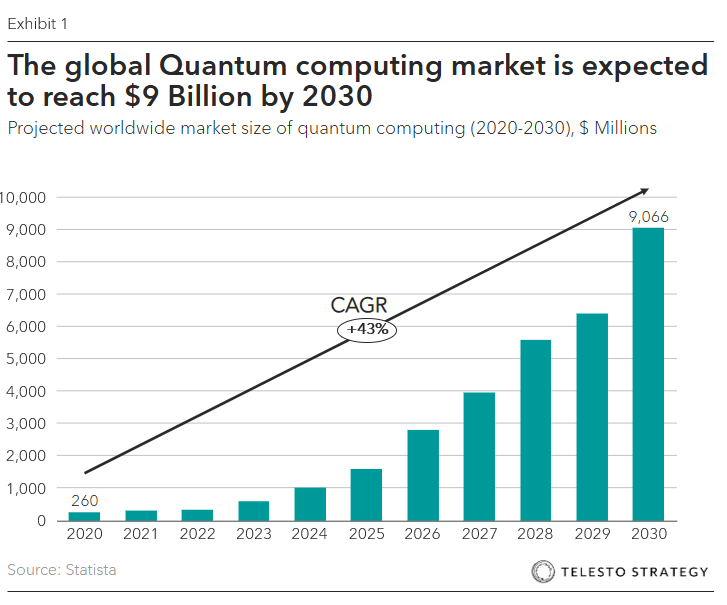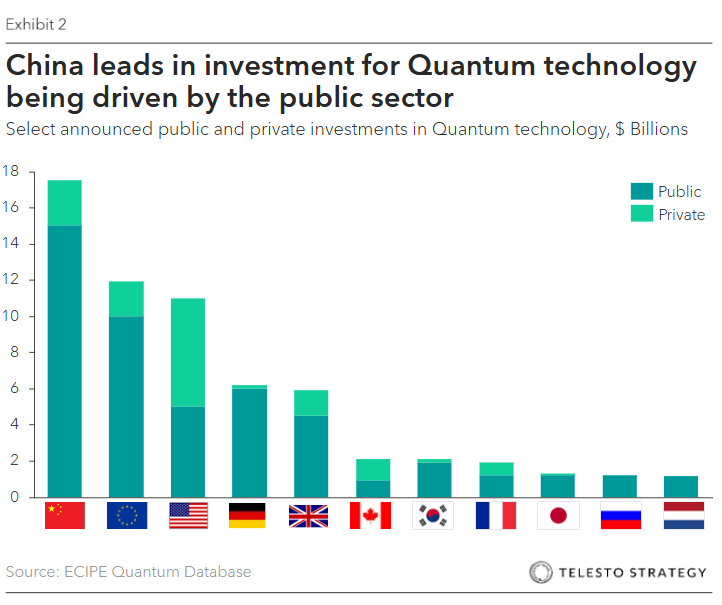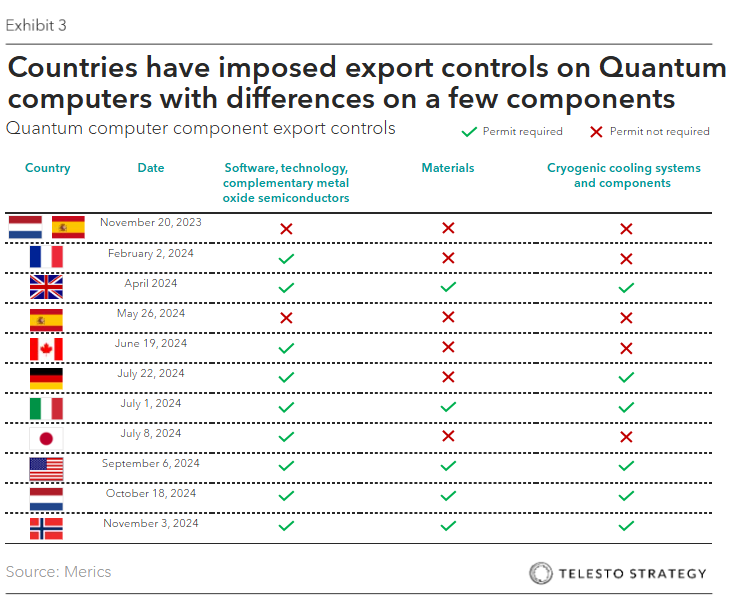
Quantum computing is moving fast from theoretical promise to boardroom strategy. With venture funding topping $2.6 billion globally in 2024, of which $1.7 billion went to U.S. companies, U.S. multinationals are launching quantum pilots and assessing their risks to encryption threats. Whether it’s big tech, pharmaceutical, or energy, if fully commercialized, analysts estimate a $2 trillion economic impact by 2035. Can your organization gain the quantum advantage?
Key takeaways:
- The potential for quantum computing commercialization is here, many leading companies have already gotten started with scaled pilots using cloud-based quantum platforms and service providers
- With the risks to classical computing encryption standards, quantum computing also poses material cyber risks; accordingly, enterprise risk management frameworks will have to be adjusted
- With major implications to U.S. national security, many expect a “quantum version” of the Cold War era space race—expect a burgeoning U.S. venture, start-up, national lab, and public-private partnership landscape
- Board members and management teams will have to gain fluency in the technology to seize the finanicla opportunities, avoid operational and competitive losses
The global quantum computing market size is expected to grow enormously over the next several years, with an expectation that it will reach $9 billion by 2030, compared to a mere $260 million in 2020.
Major tech firms like IBM, Google, Microsoft, Quantinuum, IonQ, and D-Wave are scaling quantum efforts and reporting commercial activity. IBM has over 250 customers using its quantum services; Terra Quantum, IonQ, and others are integrating quantum into financial modeling and ML workflows.

First, a primer – what is quantum computing?
Quantum computing is a fundamentally different paradigm of computation that leverages the laws of quantum mechanics — especially superposition, entanglement, and interference — to process information in ways that classical computers cannot.
- Classical computers use bits (0 or 1) to process data sequentially
- Quantum computers use qubits, which can exist as 0, 1, or both simultaneously (superposition), and can be entangled to affect each other’s state, regardless of distance
This allows quantum computers to explore a vast number of possible solutions simultaneously, offering potential exponential speed-ups for certain classes of problems, especially those involving:
- Optimization
- Cryptography
- Drug discovery
- Materials simulation
- Logistics and route planning
| Quantum | AI | |
|---|---|---|
| Description | New computing architecture | Software techniques running on classical hardware |
| Core functionality | Solves complex problems via quantum physics | Learns patterns form data to make predictions or decisions |
| Hardware requirement | Needs specialized hardware (e.g., ion traps, superconducting qubits) | Runs on GPUs, CPUs, or TPUs |
The new “Power Couple” – how quantum computing and AI will work together
Quantum computing and AI are complementary, not competitive. Quantum systems will enhance AI capabilities in several ways:
- Quantum machine learning (QML): Quantum algorithms can potentially speed up the training of AI models by accelerating linear algebra operations (e.g., solving high-dimensional systems)
- Optimization for AI. Quantum computers can improve decision-making in AI models by quickly finding optimal solutions in large, complex search spaces
- New AI architectures. Quantum hardware may allow for radically different model architectures not feasible with classical systems
National security implications
The U.S. and China consider quantum computing a geopolitical frontier akin to a Cold War arms race — whoever leads may dominate critical fields like cryptography, sensing, materials science, finance, and defense.
While the U.S. retains strength in quantum computing research and private-sector innovation, China leads in quantum communications and sensing, and has built a state-backed ecosystem from satellite, QKD to commercial startups.
Accordingly, the U.S. has enacted a range of policy tools:
- Investment restrictions. Under Treasury rules, U.S. entities are barred from financing Chinese quantum firms effective January 2, 2025
- Federal funding. Through the U.S. Innovation and Competition Act, the CHIPS & Science Act, and the Quantum Sandbox for Near-Term Applications Act, billions are being directed to quantum tech, workforce training, and public-private testbeds
- Export controls. Have been applied to quantum-capable computing hardware and talent sharing to China, which began in 2022 and expanded to protect national security interests


Sustainability implications
Electricity demand, which is already spiking alongside the proliferation of data centers related to AI’s adoption, will also increase with the load needed to run utility-scaled quantum computers. However, because quantum systems perform certain specialized tasks with much lower energy per operation, the incremental power demand from quantum deployments is lessened. Cooling, though, will be a major factor. In quantum computing, cooling often dominates total energy use, unlike classical systems.
On the flip side, quantum computing is poised to revolutionize electricity systems by optimizing grid management, enhancing renewable energy integration, and improving energy storage solutions. Quantum algorithms can analyze complex grid data, predict failures, optimize energy distribution, and even accelerate the development of new materials for more efficient energy storage.
Actions boards can take:
- Develop a Quantum strategy. Boards should start by mapping pain points that quantum could address (e.g., optimization, simulation, ML, cryptography). Evaluate early-mover advantage opportunities to consider how quantum innovation could unlock new revenue, efficiency, or progression of broad strategic goals
- Launch Pilot use cases and build skills. Begin experimentation with cloud-based platforms (e.g., IBM, Azure, Amazon Braket) via simulations and pilot projects
- Invest in internal Quantum literacy. Consider a board education session featuring external quantum experts or partners
- Assess risk and readiness. Schedule a quantum risk and readiness briefing from the CIO, CTO, and CISO in the next 6-12 months. Review third-party dependencies on whether key suppliers are partners are incorporating quantum-resistant security
- Enhance cybersecurity dashboards. Add quantum to the board’s technology and cybersecurity dashboards, include quantum-related risk integration and assessment
- Monitor partnership opportunities. Evaluate startups and hyperscalers, engage in public-private programs (e.g., U.S. Sandbox) to access shared infrastructure and reduce risk
- Assess net carbon footprint. Understand the implications to energy uses and net carbon footprint (including downstream emissions reductions)
Questions for the boardroom:
- Which competitors, peers, or disruptors are already investing in quantum computing or participating in quantum pilots? What can we learn from their results to date?
- Are we actively tracking quantum investments by hyperscalers like IBM, Microsoft, Amazon, or Google that could affect our market or industry? How will we engage with the quantum ecosystem?
- Is our company vulnerable to quantum-enabled attacks on our encryption systems (e.g., crypto-agility risks)?
- What is our plan to transition to post-quantum cryptography (PQC)?
- Have we inventoried the systems, suppliers, and customer data flows that depend on classical encryption methods?
- Do we have internal teams or partnerships exploring quantum algorithms, quantum machine learnings, or quantum optimization?
- Which competitors, peers, or disruptors are already investing in quantum computing or participating in quantum pilots?
- Are we actively tracking quantum investments by hyperscalers like IBM, Microsoft, Amazon, or Google that could affect our market or industry?
- Is our company vulnerable to quantum-enabled attacks on our encryption systems (e.g., crypto-agility risks)?
- What is our plan to transition to post-quantum cryptography (PQC)?
- Have we inventoried the systems, suppliers, and customer data flows that depend on classical encryption methods?
- Do we have internal teams or partnerships exploring quantum algorithms, quantum machine learnings, or quantum optimization?
Additional Telesto resources:
- BoardCollective, equips your organization’s corporate directors and leaders with the insights and knowledge necessary to stay up to date, mitigate risks, and seize business opportunities associated with sustainability, climate, and ESG
- The Golden Dome moment: A new agenda for national security and innovation – Telesto
- Making sense of corporate sustainability and ESG’s history: A primer for board members
- China hits back: What do Beijing’s countermeasures mean for U.S. businesses




